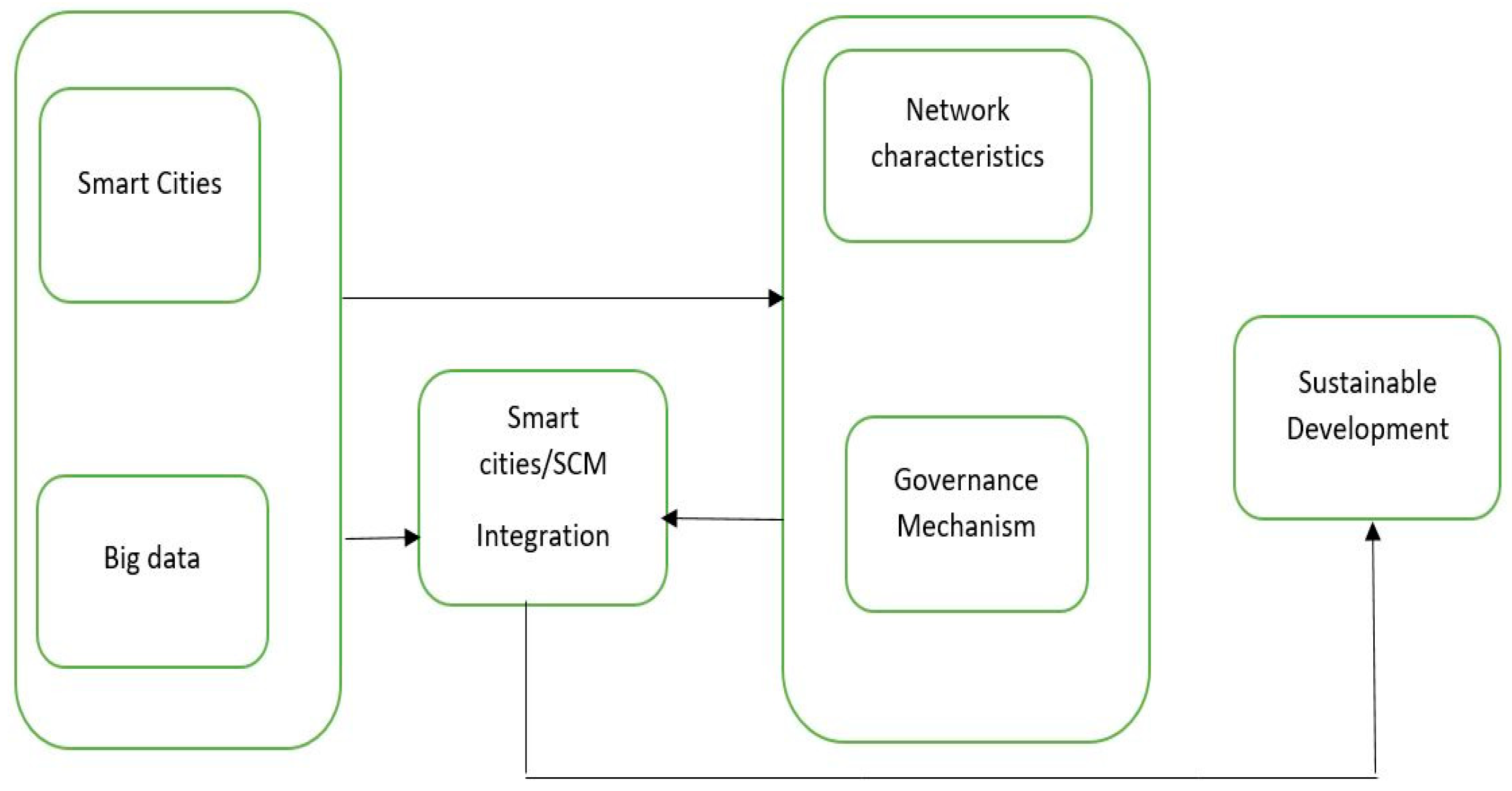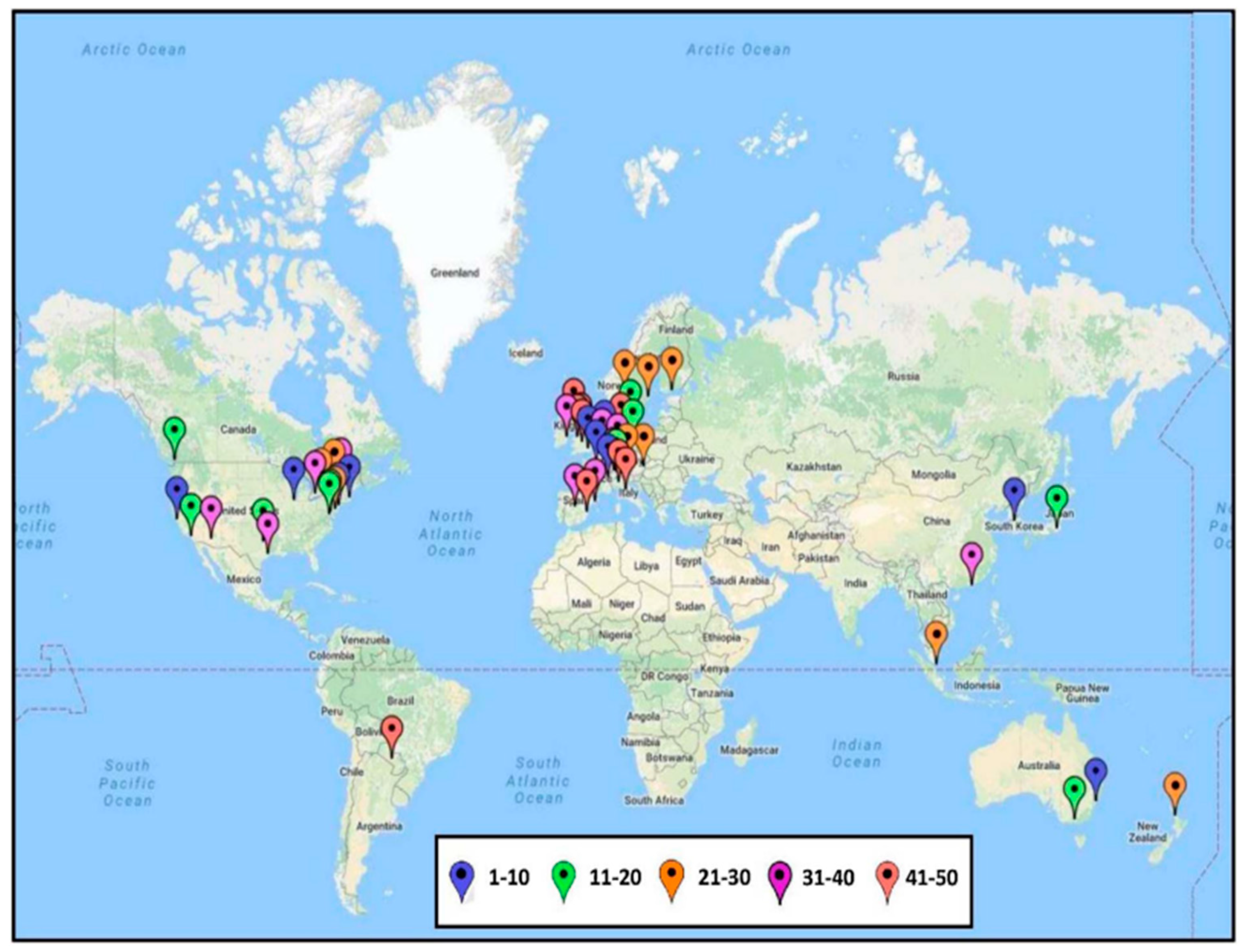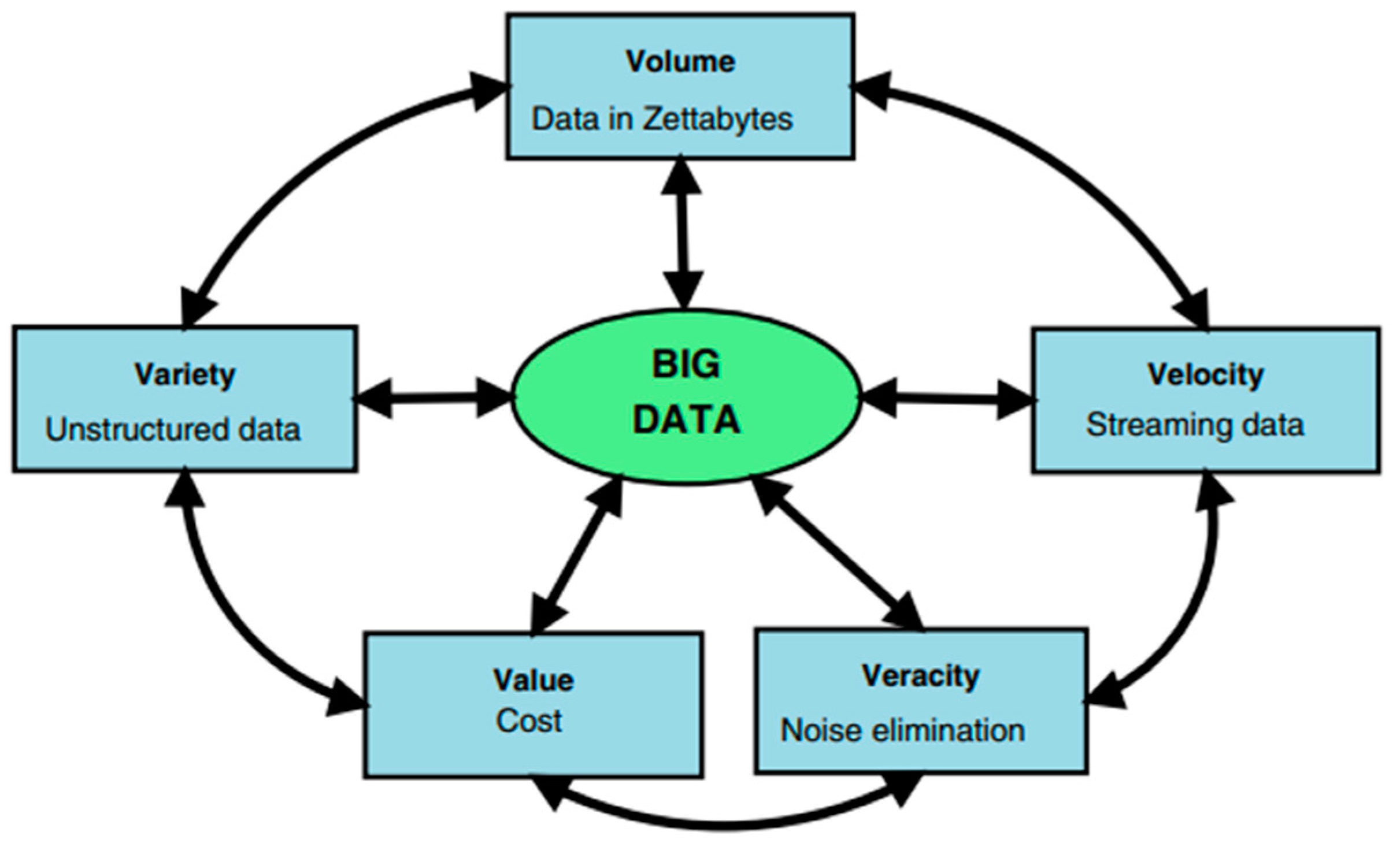Connections between Big Data and Smart Cities from the Supply Chain Perspective: Understanding the Impact of Big Data
Abstract
1. Introduction
2. The Integrative Framework
3. The City Landscape (Left-Hand Side of the Framework)
3.1. Smart Cities
3.2. Big Data
3.3. Integration of Supplier Network and Smart Cities
4. Analysis
4.1. Integration of Big Data, Smart Cities and Network Density
4.2. The Integration of Network Centralization, Smart Cities and Big Data
4.3. The Integration of Big Data, Smart Cities, and Network Complexity
4.4. Integration of Big Data, Smart Cities, and Governance Mechanisms
4.5. Smart Cities, Big Data Integration with SCM and Sustainable Development
5. Conclusions
5.1. Theortical Contribution
5.2. Managerial Contribution
6. Future Research
Author Contributions
Funding
Institutional Review Board Statement
Informed Consent Statement
Data Availability Statement
Conflicts of Interest
References
- García-Holgado, A.; García-Peñalvo, F.J.; Butler, P. Technological Ecosystems in Citizen Science: A Framework to Involve Children and Young People. Sustainability 2020, 12, 1863. [Google Scholar] [CrossRef]
- Lierow, M. B2City: The next wave of urban logistics. Supply Chain. 2014, 247, 41–48. [Google Scholar]
- Burt, J.A. The environmental costs of coastal urbanization in the Arabian Gulf. City 2014, 18, 760–770. [Google Scholar] [CrossRef]
- Zambon, I.; Colantoni, A.; Carlucci, M.; Morrow, N.; Sateriano, A.; Salvati, L. Land quality, sustainable development and environmental degradation in agricultural districts: A computational approach based on entropy indexes. Environ. Impact Assess. Rev. 2017, 64, 37–46. [Google Scholar] [CrossRef]
- Cantuarias-Villessuzanne, C.; Weigel, R.; Blain, J. Clustering of European smart cities to understand the cities’ sus-tainability strategies. Sustainability 2021, 13, 513. [Google Scholar] [CrossRef]
- Yigitcanlar, T. Smart city policies revisited: Considerations for a truly smart and sustainable urbanism practice. World Technopolis Rev. 2018, 7, 97–112. [Google Scholar]
- Laconte, P. Smart and Sustainable Cities: What Is Smart?—What Is Sustainable? In International Conference on Smart and Sustainable Planning for Cities and Regions; Springer: Cham, Switzerland, 2017; pp. 3–19. [Google Scholar]
- Lee, S.Y.; Lee, J.E. Investigation on Smart City Objectives and Implications: Adaption to Silver Population in Korea as Target Citizens. J. Korea Contents Assoc. 2017, 17, 470–478. [Google Scholar]
- Manville, C.; Cochrane, G.; Jonathan, C.A.V.E.; Millard, J.; Pederson, J.K.; Thaarup, R.K.; WiK, M.W. Mapping Smart Cities in the EU; Mapping Smart Cities in the EU | Policy Commons; European Parliament: Strasbourg, France, 2014. [Google Scholar]
- Gil-Garcia, J.R.; Helbig, N.; Ojo, A. Being smart: Emerging technologies and innovation in the public sector. Gov. Inf. Q. 2014, 31, I1–I8. [Google Scholar] [CrossRef]
- Gasco-Hernandez, D.M. Is it more than using data and technology in local governments? Identifying opportunities and challenges for cities to become smarter. UMKC Law Rev. 2017, 85, 915. [Google Scholar]
- Pan, S.; Zhou, W.; Piramuthu, S.; Giannikas, V.; Chen, C. Smart city for sustainable urban freight logistics. Int. J. Prod. Res. 2021, 59, 2079–2089. [Google Scholar] [CrossRef]
- Bibri, S.E.; Krogstie, J. Smart sustainable cities of the future: An extensive interdisciplinary literature review. Sustain. Cities Soc. 2017, 31, 183–212. [Google Scholar] [CrossRef]
- Kim, Y.; Choi, T.Y.; Yan, T.; Dooley, K. Structural investigation of supply networks: A social network analysis approach. J. Oper. Manag. 2010, 29, 194–211. [Google Scholar] [CrossRef]
- Angelidou, M.; Psaltoglou, A.; Komninos, N.; Kakderi, C.; Tsarchopoulos, P.; Panori, A. Enhancing sustainable urban development through smart city applications. J. Sci. Technol. Policy Manag. 2017, 9, 146–169. [Google Scholar] [CrossRef]
- Mohanty, S.P.; Choppali, U.; Kougianos, E. Everything you wanted to know about smart cities: The Internet of things is the backbone. IEEE Consum. Electron. Mag. 2016, 5, 60–70. [Google Scholar] [CrossRef]
- Silva, B.N.; Khan, M.; Jung, C.; Seo, J.; Yoon, Y.; Kim, J.; Han, K. Planning of smart cities Performance improvement using big data analytics approach. In Proceedings of the Fourth International Conference on Advances in Computing, Electronics and Communication, Rome, Italy, 15–16 December 2016; pp. 51–55. Available online: https://www.seekdloi.org/conferences10.15224/paper/details/9784-1-63248-113-9-11.html (accessed on 30 August 2022).
- Harrison, C.; Eckman, B.; Hamilton, R.; Hartswick, P.; Kalagnanam, J.; Paraszczak, J. Foundations for smarter cities. IBM J. Res. Dev. 2010, 54, 1–16. [Google Scholar] [CrossRef]
- Komninos, N.; Kakderi, C.; Panori, A.; Tsarchopoulos, P. Smart City Planning from an Evolutionary Perspective. J. Urban Technol. 2017, 26, 3–20. [Google Scholar] [CrossRef]
- Kim, Y.; Chen, Y.-S.; Linderman, K. Supply network disruption and resilience: A network structural perspective. J. Oper. Manag. 2015, 33–34, 43–59. [Google Scholar] [CrossRef]
- Gharaibeh, A.; Salahuddin, M.A.; Hussini, S.J.; Khreishah, A.; Khalil, I.; Guizani, M.; Al-Fuqaha, A. Smart Cities: A Survey on Data Management, Security, and Enabling Technologies. IEEE Commun. Surv. Tutorials 2017, 19, 2456–2501. [Google Scholar] [CrossRef]
- Pombo, C.; Gupta, R.; Stankovic, M. Social Services for Digital Citizens: Opportunities for Latin America and the Caribbean; Inter-American Development Bank: Washington, DC, USA, 2018. [Google Scholar]
- Fraga, L.P.; Fernández, T. A review on blockchain technologies for an advanced and cyber-resilient automotive industry. IEEE access 2019, 7, 17578–17598. [Google Scholar] [CrossRef]
- Bradley, E.; Laraichi, O.; Ryan, M.; Tripathy, S.; VanDerSchaaf, H.; Daim, T.U. Technology management: Case of the internet of technologies and smart city. In Research and Development Management; Springer: Cham, Switzerland, 2017; pp. 275–292. [Google Scholar]
- Kaffash, S.; Nguyen, A.; Zhu, J. Big data algorithms and applications in intelligent transportation system: A review and bibliometric analysis. Production Economic Int. J. 2021, 231, 107868. [Google Scholar] [CrossRef]
- Van Meldert, B.; De Boeck, L. Introducing autonomous vehicles in logistics: A review from a broad perspective. In FEB Research Report KBI_1618; KU Leuven: Leuven, Belgium, 2016. [Google Scholar]
- Guerrero-Ibáñez, J.; Zeadally, S.; Contreras-Castillo, J. Sensor Technologies for Intelligent Transportation Systems. Sensors 2018, 18, 1212. [Google Scholar] [CrossRef]
- Chauhan, S.; Agarwal, N.; Kar, A.K. Addressing big data challenges in smart cities: A systematic literature review. Info 2016, 18, 73–90. [Google Scholar] [CrossRef]
- Allam, Z.; Sharifi, A.; Bibri, S.E.; Jones, D.S.; Krogstie, J. The Metaverse as a Virtual Form of Smart Cities: Opportunities and Challenges for Environmental, Economic, and Social Sustainability in Urban Futures. Smart Cities 2022, 5, 771–801. [Google Scholar] [CrossRef]
- Fosso-Wamba, S.; Akter, S.; Edwards, A.; Chopin, G.; Gnanzou, D. How ‘Big Data’ can make big impact: Findings from a systematic review and a longitudinal case study. Int. J. Prod. Econ. 2015, 165, 234–246. [Google Scholar] [CrossRef]
- Lomotey, R.K.; Deters, R. Towards knowledge discovery in Big Data. In Proceedings of the 2014 IEEE 8th International Symposium on Service Oriented System Engineering, Oxford, UK, 7–11 April 2014; pp. 181–191. [Google Scholar]
- Laney, D. 3D data management: Controlling data volume, velocity and variety. META Group Res. Note 2001, 6, 1. [Google Scholar]
- Kache, F.; Seuring, S. Challenges and opportunities of digital information at the intersection of Big Data Analytics and supply chain management. Int. J. Oper. Prod. Manag. 2017, 37, 10–36. [Google Scholar] [CrossRef]
- Tyagi, A.K. Machine learning with Big Data. In Proceedings of the International Conference on Sustainable Computing in Science, Technology and Management (SUSCOM), Amity University Rajasthan, Jaipur, India, 26–28 February 2019. [Google Scholar]
- Adam, K.; Fakharaldien, M.A.I.; Zain, J.M.; Majid, M.A.; Noraziah, A. Bigdata: Issues, challenges, Technologies and Methods. In Proceedings of the International Conference on Data Engineering 2015 (DaEng-2015) 541–550, Seoul, Republic of Korea, 13–17 April 2015; Springer: Singapore, 2019. [Google Scholar]
- Verhoeven, P.; Sinn, F.; Herden, T.T. Examples from Blockchain Implementations in Logistics and Supply Chain Management: Exploring the Mindful Use of a New Technology. Logistics 2018, 2, 20. [Google Scholar] [CrossRef]
- Hayashi, A.M. Thriving in a Big Data world. MIT Sloan Manag. Rev. 2014, 55, 35. [Google Scholar]
- Huang, T.; Van Mieghem, J.A. Clickstream Data and Inventory Management: Model and Empirical Analysis. Prod. Oper. Manag. 2013, 23, 333–347. [Google Scholar] [CrossRef]
- Shu, J.; Barton, R. Managing Supply Chain Execution: Monitoring Timeliness and Correctness via Individualized Trace Data. Prod. Oper. Manag. 2012, 21, 715–729. [Google Scholar] [CrossRef]
- Bahrami, M.; Shokouhyar, S.; Seifian, A. Big data analytics capability and supply chain performance: The mediating roles of supply chain resilience and innovation. Mod. Supply Chain Res. Appl. 2022, 4, 62–84. [Google Scholar] [CrossRef]
- Stephenson, D. Big Data Demystified: How to use Big Data, Data Science and AI to Make Better Business Decisions and Gain Competitive Advantage; Pearson: London, UK, 2018. [Google Scholar]
- Harford, T. Big data: A big mistake? Significance 2014, 11, 14–19. [Google Scholar] [CrossRef]
- Davenport, T.H.; Barth, P.; Bean, R. How Big Data is different. MIT Sloan Manag. Rev. 2012, 54, 43–46. [Google Scholar]
- Tachizawa, E.M.; Alvarez-Gil, M.J.; Montes-Sancho, M.J. How “smart cities” will change supply chain management. Supply Chain. Manag. Int. J. 2015, 20, 237–248. [Google Scholar] [CrossRef]
- Öberg, C.; Graham, G. How smart cities will change supply chain management: A technical viewpoint. Prod. Plan. Control 2016, 27, 529–538. [Google Scholar] [CrossRef]
- Letnik, T.; Marksel, M.; Luppino, G.; Bardi, A.; Božičnik, S. Review of policies and measures for sustainable and energy efficient urban transport. Energy 2018, 163, 245–257. [Google Scholar] [CrossRef]
- Treiblmaier, H. Optimal levels of (de)centralization for resilient supply chains. Int. J. Logist. Manag. 2018, 29, 435–455. [Google Scholar] [CrossRef]
- Kumar, M.; Graham, G.; Hennelly, P.; Srai, J. How will smart city production systems transform supply chain design: A product-level investigation. Int. J. Prod. Res. 2016, 54, 7181–7192. [Google Scholar] [CrossRef]
- Manavalan, E.; Jayakrishna, K. A review of Internet of Things (IoT) embedded sustainable supply chain for industry 4.0 requirements. Comput. Ind. Eng. 2018, 127, 925–953. [Google Scholar] [CrossRef]
- Lu, M.; Blokpoel, R.; Fünfrocken, M.; Castells, J. Open architecture for internet-based C-ITS services. In Proceedings of the 2018 21st International Conference on Intelligent Transportation Systems (ITSC), Maui, HI, USA, 4–7 November 2018; pp. 7–13. [Google Scholar]
- Rudin. 2014. Available online: http://reprogrammingmobility.org/wp-content/uploads/2014/09/Re-Programming-Mobility-Report.pdf (accessed on 7 July 2022).
- Francisco, K.; Swanson, D. The Supply Chain Has No Clothes: Technology Adoption of Blockchain for Supply Chain Transparency. Logistics 2018, 2, 2. [Google Scholar] [CrossRef]
- Chopra, S.; Meindl, P. Supply Chain Management: Strategy, Planning and Operations; Pearson: Upper Saddle River, NJ, USA, 2013. [Google Scholar]
- Sivarajah, U.; Kamal, M.M.; Irani, Z.; Weerakkody, V. Critical analysis of Big Data challenges and analytical methods. J. Bus. Res. 2017, 70, 263–286. [Google Scholar] [CrossRef]
- Koot, M.; Mes, M.R.; Iacob, M.E. A systematic literature review of supply chain decision making supported by the Internet of Things and Big Data Analytics. Comput. Ind. Eng. 2020, 154, 107076. [Google Scholar] [CrossRef]
- Benabdellah, A.C.; Bouhaddou, I.; Benghabrit, A. Supply chain challenges with complex adaptive system perspective. In World Conference on Information Systems and Technologies; Springer: Cham, Switzerland, 2018; pp. 1081–1093. [Google Scholar]
- Yigitcanlar, T. Technology and the City: Systems, Applications and Implications; Routledge: Oxfordshire, UK, 2016. [Google Scholar]
- Hallo, L.; Nguyen, T.; Gorod, A.; Tran, P. Effectiveness of Leadership Decision-Making in Complex Systems. Systems 2020, 8, 5. [Google Scholar] [CrossRef]
- Serdarasan, S. A review of supply chain complexity drivers. Comput. Ind. Eng. 2013, 66, 533–540. [Google Scholar] [CrossRef]
- Alvarez, G.; Pilbeam, C.; Wilding, R. Nestlé Nespresso AAA sustainable quality program: An investigation into the governance dynamics in a multi-stakeholder supply chain network. Supply Chain Manag. Int. J. 2010, 15, 165–182. [Google Scholar] [CrossRef]
- Gulati, R.; Singh, H. The Architecture of Cooperation: Managing Coordination Costs and Appropriation Concerns in Strategic Alliances. Adm. Sci. Q. 1998, 43, 781. [Google Scholar] [CrossRef]
- Raab, J. Powell Neither Market nor Hierarchy: Network Forms of Organization. In Schlüsselwerke der Netzwerkforschung; Springer VS: Wiesbaden, Germany, 1990; pp. 461–463. [Google Scholar]
- Von, C.; Loch, C. Contracting for major projects: Eight business levers for top management. Project Manag. Int. J. 2004, 22, 119–130. [Google Scholar]
- Skilton, P.F.; Robinson, J.L. Traceability and normal accident theory: How does supply network complexity influence the traceability of adverse events? J. Supply Chain. Manag. 2009, 45, 40–53. [Google Scholar] [CrossRef]
- Rogers, E.M. Diffusion of Innovations; Free Press: New York, NY, USA, 2003; p. 551. [Google Scholar]
- Wu, Y.; Cegielski, C.G.; Hazen, B.T.; Hall, D.J. Cloud Computing in Support of Supply Chain Information System Infrastructure: Understanding When to go to the Cloud. J. Supply Chain Manag. 2013, 49, 25–41. [Google Scholar] [CrossRef]
- Melville, N.; Ramirez, R. Information technology innovation diffusion: An information requirements paradigm. Inf. Syst. J. 2008, 18, 247–273. [Google Scholar] [CrossRef]
- Kezar, A.; Eckel, P.D. Meeting today’s governance challenges: A synthesis of the literature and examination of a future agenda for scholarship. J. High. Educ. 2004, 75, 371–399. [Google Scholar] [CrossRef]
- Prashant, K.; Harbir, S. Managing strategic alliances: What do we know now, and where do we go from here? Acad. Manag. Perspect. 2009, 23, 45–62. [Google Scholar] [CrossRef]
- Schmoltzi, C.; Wallenburg, C.M. Operational Governance in Horizontal Cooperations of Logistics Service Providers: Performance Effects and the Moderating Role of Cooperation Complexity. J. Supply Chain Manag. 2012, 48, 53–74. [Google Scholar] [CrossRef]
- Wise, S. Can a team have too much cohesion? The dark side to network density. J. Europ. Manag. 2014, 32, 703–711. [Google Scholar] [CrossRef]
- Pilbeam, C.; Alvarez, G.; Wilson, H. The governance of supply networks: A systematic literature review. Supply Chain Manag. Int. J. 2012, 17, 358–376. [Google Scholar] [CrossRef]
- Roseland, M. Toward Sustainable Communities: Solutions for Citizens and Their Governments; New Society Publishers: Gabriola Island, BC, Canada, 2012. [Google Scholar]
- Al Nuaimi, E.; Al Neyadi, H.; Mohamed, N.; Al-Jaroodi, J. Applications of big data to smart cities. J. Internet Serv. Appl. 2015, 6, 1–15. [Google Scholar] [CrossRef]
- Belli, L.; Cilfone, A.; Davoli, L.; Ferrari, G.; Adorni, P.; Di Nocera, F.; Bertolotti, E. IoT-enabled smart sustainable cities: Challenges and approaches. Smart Cities 2020, 3, 1039–1071. [Google Scholar] [CrossRef]
- Deja, A.; Dzhuguryan, T.; Dzhuguryan, L.; Konradi, O.; Ulewicz, R. Smart Sustainable City Manufacturing and Logistics: A Framework for City Logistics Node 4.0 Operations. Energies 2021, 14, 8380. [Google Scholar] [CrossRef]
- Karaman, A.S.; Kilic, M.; Uyar, A. Green logistics performance and sustainability reporting practices of the logistics sector: The moderating effect of corporate governance. J. Clean. Prod. 2020, 258, 120718. [Google Scholar] [CrossRef]
- Coletta, C.; Heaphy, L.; Kitchin, R. From the accidental to articulated smart city: The creation and work of ‘Smart Dublin’. Eur. Urban Reg. Stud. 2018, 26, 349–364. [Google Scholar] [CrossRef]
- Cantini, A.; Peron, M.; De Carlo, F.; Sgarbossa, F. A decision support system for configuring spare parts supply chains considering different manufacturing technologies. Int. J. Prod. Res. 2022, 1–21. [Google Scholar] [CrossRef]
- Kitchin, R. Big Data, new epistemologies and paradigm shifts. Big Data Soc. 2014, 1, 2053951714528481. [Google Scholar] [CrossRef]
- Manyika, J.; Lund, S.; Bughin, J. Digital Globalization: The New Era Global Flows; McKinsey Global Institute: Washington, DC, USA, 2016. [Google Scholar]



Publisher’s Note: MDPI stays neutral with regard to jurisdictional claims in published maps and institutional affiliations. |
© 2022 by the authors. Licensee MDPI, Basel, Switzerland. This article is an open access article distributed under the terms and conditions of the Creative Commons Attribution (CC BY) license (https://creativecommons.org/licenses/by/4.0/).
Share and Cite
Abdalla, A.A.; Abdalla, Y.A.; Haddad, A.M.; Bhavani, G.; Zabalawi, E. Connections between Big Data and Smart Cities from the Supply Chain Perspective: Understanding the Impact of Big Data. Sustainability 2022, 14, 16161. https://doi.org/10.3390/su142316161
Abdalla AA, Abdalla YA, Haddad AM, Bhavani G, Zabalawi E. Connections between Big Data and Smart Cities from the Supply Chain Perspective: Understanding the Impact of Big Data. Sustainability. 2022; 14(23):16161. https://doi.org/10.3390/su142316161
Chicago/Turabian StyleAbdalla, Alaa Amin, Yousif Abdelbagi Abdalla, Akarm M. Haddad, Ganga Bhavani, and Eman Zabalawi. 2022. "Connections between Big Data and Smart Cities from the Supply Chain Perspective: Understanding the Impact of Big Data" Sustainability 14, no. 23: 16161. https://doi.org/10.3390/su142316161
APA StyleAbdalla, A. A., Abdalla, Y. A., Haddad, A. M., Bhavani, G., & Zabalawi, E. (2022). Connections between Big Data and Smart Cities from the Supply Chain Perspective: Understanding the Impact of Big Data. Sustainability, 14(23), 16161. https://doi.org/10.3390/su142316161






